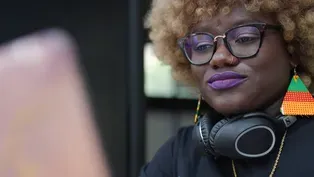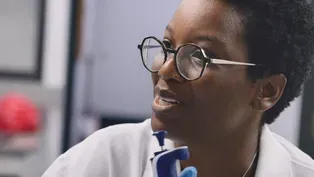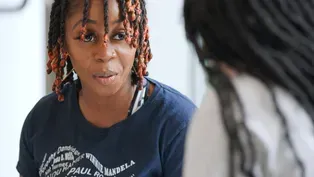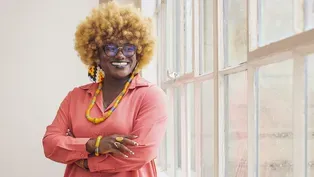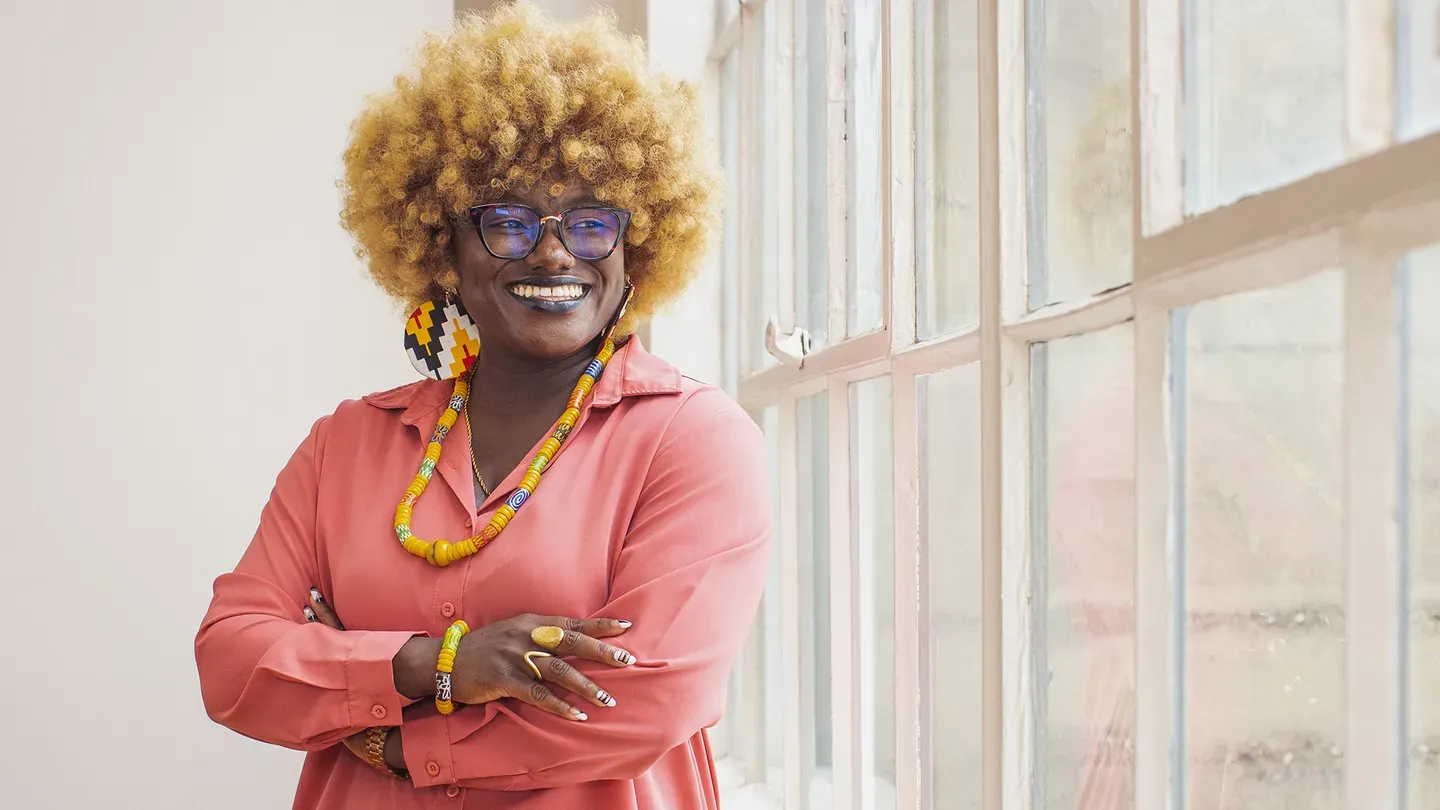

SciGirls Stories: Black Women in STEM
6/1/2023 | 25m 48sVideo has Closed Captions
Meet five Black women scientists who are innovators, problem-solvers and STEM superstars.
Meet five Black women scientists who are innovators, problem-solvers and STEM superstars who honor their racial identity and cultures. In this show, they share their strategies for overcoming challenges and finding success and joy in jobs where Black women are often underrepresented. They also inspire Black girls to pursue all kinds of interests and career paths through their individual stories.
Problems with Closed Captions? Closed Captioning Feedback
Problems with Closed Captions? Closed Captioning Feedback

SciGirls Stories: Black Women in STEM
6/1/2023 | 25m 48sVideo has Closed Captions
Meet five Black women scientists who are innovators, problem-solvers and STEM superstars who honor their racial identity and cultures. In this show, they share their strategies for overcoming challenges and finding success and joy in jobs where Black women are often underrepresented. They also inspire Black girls to pursue all kinds of interests and career paths through their individual stories.
Problems with Closed Captions? Closed Captioning Feedback
How to Watch SciGirls Stories: Black Women in STEM
SciGirls Stories: Black Women in STEM is available to stream on pbs.org and the free PBS App, available on iPhone, Apple TV, Android TV, Android smartphones, Amazon Fire TV, Amazon Fire Tablet, Roku, Samsung Smart TV, and Vizio.
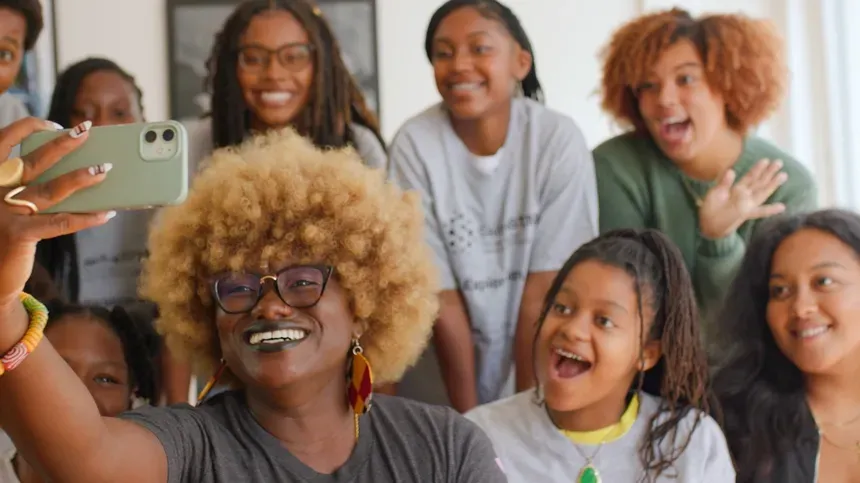
SciGirls
Learn more about SciGirls, the Emmy award-winning PBS Kids television show, website and outreach program.Providing Support for PBS.org
Learn Moreabout PBS online sponsorship(upbeat music) - My absolute favorite part is being able to design.
That's what I love the most.
I love being able to go out and take an idea and make it an actual lesson.
- One of the things I try to work on is I try to encourage a lot of, especially Black young women who want to go into STEM, I try to encourage 'em, because that is the only way we can change the conversation.
And if there isn't a seat for you at the table, well, Shirley Chisholm said to bring your own chair.
But I love to even build my own table.
(upbeat music continuing) - I think there's ways to go, but I think that a lot of Black women in STEM have been speaking up lately, and have been moving into these positions where we're able to enact change.
There are a lot more Black women in STEM who are visible now, and I can speak for any of us when I say that we are more than happy to help any Black girl who is interested in STEM.
- I am drawing and learning about other types of science, because I am drawing the people that do it.
So, it was a really unique way that I found that I can combine these two loves and also just share more knowledge.
- Being corely a Black lab makes us more unique than any of the other labs that are here.
♪ We're unstoppable (music ending) (uplifting music) - I have a very adventurous soul.
It is my job to make online courses easy.
We literally design courses for the online environment, so that it's fun and it's easy to use.
My name is Shakiyla Huggins.
I'm a learning experience designer at Duke University.
My absolute favorite part is being able to design.
That's what I love the most.
I love being able to go out and take an idea and make it an actual lesson.
So, when I was young, I would always be the student that finished their work in like seven seconds, and then would start bothering other students.
So, I had a fifth grade teacher that noticed that about me and so she went to my parents and she was saying, "I think she's just bored and she needs more of a challenge."
And so she took me in on Saturdays.
She would teach me more challenging math.
So, I was in a fifth grade doing sixth and seventh grade math, and it really helped, because I was like, wow, I'm really good at math.
I can actually do this.
From there, I just kept shining.
I kept shining.
I kinda, in a sense, always knew what I wanted to do, because that one fifth grade teacher put me on the right path to be able to say like, education, specifically, STEM education is where I shine the brightest.
And so I wanted to be able to give that back to other students.
And so I went and got my master's in math.
Also got a second master's in teaching, so that I can show other students that education in STEM is attainable for anybody that wants to put their energy and their love into it.
You just have to have somebody that believes in you, and have somebody that understands you, and have somebody that's gonna help teach you in a way that you need to be taught.
So, you can see just how beautiful and bright STEM really is.
- Ah, I got it, yeah.
(drumming) - I've always just love the sound of music.
It literally soothes my soul.
Not only that, I also have a lot of dogs.
I absolutely love dogs.
I've had dogs my whole life.
When the music is going and I have my dogs running around and playing, I'm literally the happiest person in the world.
I can say the biggest challenge was losing my mom.
My mom passed away in May of 2021, and it was very hard for me to continue, but honestly, I was able to keep going, because I knew that I still had a goal and I wanted to reach those goals.
If I could go back in time and give myself advice, I would tell myself, no matter what, just keep going.
Life may not always be exactly what you dreamed of, but always find a reason to keep going.
You're gonna end up exactly where you want to be.
(music ending) - My favorite thing about being in the research lab is that I actually get to see a lot of really cool stuff every day.
Lots of pictures and things that are usually inside of our bodies that we don't get to see on the outside.
(upbeat music) My name is Jazmine Benjamin.
I am a graduate student at the University of Alabama at Birmingham.
Growing up, I spent a lot of time by myself, and I was also really curious.
I would go outside and you know, pick up bugs.
Looking back now, I think I always had the makings of a scientist.
I was always really curious, but also my parents really pushed me to do my own research.
And I think that having experiences like that and learning to have a question and figure out the answer for myself before necessarily going and asking someone to give me the answer really led to them fostering that curiosity well into my adult life.
Being a Black woman who's also a scientist is, it's a fun intersection to be at.
Parts of my work that give me enjoyment, really getting this talk about my research, especially with the people that it affects.
So, presenting myself as a scientist to young students in elementary and middle school, and just letting them ask me questions.
I do a lot of work on high blood pressure, and a lot of the students would say, "Oh, my grandmother has high blood pressure."
And then they would ask me questions about that.
So, you would see their eyes light up.
'Cause finally it's something that they can directly relate to that they can go home and talk to their family about.
The value in removing barriers in STEM for diverse individuals, it's immense value in doing that.
And I think that we're learning that right now.
If I walk into a classroom and someone who doesn't look like me is teaching, and I'm only seeing people who don't look like me in the book, I'm not gonna feel like I belong there.
I'm not gonna feel like this is a career trajectory that I can take.
But if I walk into a room and there is someone who looks like me and sounds like me that's teaching this material, I'm gonna feel more of a personal connection to the material.
But I'll also be more likely to interact with the professor, making sure that they, again, see themselves in these STEM fields.
And so I think just the visibility is the biggest thing.
Making sure that Black women are there, that they're front and center.
Removing barriers like that will lead to people thinking in different ways.
Here's my dad and this celebrating my birthday, I believe.
Then this is my mom.
This was actually taken at my best friend's wedding.
My mom is one of my favorite people.
I'm a lot like her.
She got her master's degree while raising three children and having a job.
And so I watched her go to work, eight hours a day, come home, make sure that we all made it to all of our extracurriculars, had dinner, did our homework.
And so watching my mom make those sacrifices is always an inspiration to me.
I'm gonna try not to cry.
(laughing) And thinking about those that came before me and the sacrifice that they made makes doing what I do worthwhile, is really the thing that keeps me going.
When I am not in the research lab, I like to cook.
Cooking is really therapeutic, because I like to think of it as very low stakes science.
And then of course, hanging out with my dog.
Running is another hobby.
It's very near and dear to me.
I have always loved running, even as a child.
The advice that I would give to Black girls who are interested in a career like mine is to not be afraid to ask questions and not be afraid to reach out to people who look like you.
As far as the future for Black women in STEM, I think there's ways to go, but I think that a lot of Black women in STEM have been speaking up lately and have been moving into these positions where we're able to enact change.
There are a lot more Black women in STEM who are visible now, and I can speak for any of us when I say that we are more than happy to help any Black girl who is interested in STEM.
I hope that my future puts me into a career where I'm able to really play to my strengths and advocate for Black women in STEM, and really still be able to communicate with the Black community about things that are going on in STEM fields, but also the success of Black women in the field which will only yield more success for Black women in the field in the future.
(music ending) (soothing upbeat music) - My name is Dr. Danielle Twum and I'm a cancer immunologist.
To explain what cancer immunology is, basically you have in your bodies an immune system, which you never, ever recognize exist until you actually get sick.
And this immune system plays a huge role in helping prevent cancer and fight cancer when you get it.
It's really exciting to know that there's so many people in different corners of the country all working together to cure cancer.
We've learned that together, we're stronger, and in the field of cancer research, we know that.
So, there is no cure that comes from the work of one person.
If we have a diversity of voices at the table contributing to how the cure must be found that is how I think that everybody is gonna get access to the different cures that are coming out.
So one of the greatest STEM initiatives I've been involved in is the If/Then initiative, which is if we support a woman in STEM, then she can change the world, which is an initiative aimed at increasing visibility a woman in STEM as role models for young children.
And we had the honor, it was the highest honor to be featured at the Smithsonian as part of Women's History Month.
We all had 3D statues of ourselves, and we had a chance to interact with the public, telling them about the different avenues that we've gone on with our science degrees.
It's been very fulfilling and I'm very proud of it.
(audience applauding) You have to make your own mold, you have to stay flexible.
When it comes to a STEM degree, you're thinking about what a scientist looks like, and you have to be like water.
Like if they pour you into any receptacle, take that shape, and you know, give it your all.
Give it 200, 300%, 1000%.
There is a lot of data out there about how a lot of marginalized groups do not have access to clinical trials, because they just don't know it.
And one doctor described a clinical trial as the bus that takes you to the cure.
And so if you don't even get access to the bus, how are you even gonna get to the cure?
So, one of the things I try to work on is I try to encourage a lot of, especially Black young women who want to go into STEM, try to encourage 'em, because that is the only way we can change the conversation.
And if there isn't a seat for you at the table well, Shirley Chisholm said to bring your own chair.
But I love to even build my own table.
I'm originally from Ghana, West Africa and I grew up in a home, my father is a software engineer, my mother is a lawyer, but my mother was not a traditional student.
And my mother was probably my first role model, because she first had my sister and I before she went to college.
And I saw how much work it was for her to juggle raising two kids and also, you know, going to college, and then becoming a lawyer on top of it.
And while she was gone, my grandmother was the one who raised us.
And if there was ever a fierce warrior woman, it was this woman.
She defended us to the end and she always told us, she's like, "It doesn't matter what you do, you have to finish your studies."
And every time I wanted to quit in graduate school, I would just hear my grandma say, "You have to finish.
You can't just leave this be.
Take a break if you have to, but you have to finish this."
I was precocious as a kid.
I asked questions all the time.
I did not take the word no as an answer.
I'm like, why?
And I had a very, very supportive family.
So, they always just put a book in my hand and said, "Look up the answer!"
Which is why I still love books to this day.
I wanted to be an astronaut.
I wanted to be a lawyer, I wanted to be a medical doctor, I wanted to go into environmental law.
I wanted to do everything.
So, it's funny how it all comes back to me being a scientist and asking why.
When I was seven, my uncle, with whom I share birthday with, he died of a brain tumor, before he had a chance to hit his 35th birthday.
It's the only time I've ever seen my mother cry.
And so in college I knew I was interested in STEM.
I knew I was interested in research, but I'd always wanted to ask, what is cancer, and why does it kill people in such a terrible way?
I don't want another child to have a story like mine.
It's been years since my uncle died, but I can still see his face clearly in my head.
And the whole point is to, what I do every day is to make sure that people get access to care that he never got a chance to.
(music ending) - [Person With Clapperboard] Jaye, take one, mark.
(upbeat music) - I definitely remember my first experiment.
I thought it was the most fascinating thing.
My name is Jaye Gardiner, and I am a cancer researcher, but I'm also an illustrator.
When I was in first grade, we did an experiment and it was literally putting celery into different cups of colored water, and I thought it was the most fascinating thing.
Cancer is a very bad disease.
It's kind of when your cells grow way too much.
If you think of a cell like a seed, like something that causes a plant to grow, the soil around it is what helps that grow.
So it can either be very, very rich with all of the nutrients that will allow that seed to grow.
Or it could be super, super dry, and if it's in a dry area, the seed won't grow.
So, what I'm looking at is effectively that soil.
For a disease, we don't want it to grow, so we wanna stay healthy and that's what our bodies are like when it's a nice dry area.
So, I'm actually trying to figure out how we can take a super rich, nutritious soil and turn it into a very dry soil, so that the cancer doesn't grow.
If I do the very literal translation of what I do, I'm moving very small liquids from tube to tube that I sometimes heat up, sometimes I freeze, sometimes I spin it really fast.
But that's kind of the mechanics of what I'm doing.
Out of that, I get to see really cool things.
It's kind of hard to think about sometime that all of that is happening just by moving small liquids around.
The way that I got to think about working on diseases in general, it kind of stems from my dad.
My dad had prostate cancer when I was 13.
I was really interested in diseases, and how they might be passed on in families.
I just looked for places that had programs in cancer biology, 'cause that's what I wanted to learn about.
As a kid, I remember my mom had me very regimented, so she was a stay-at-home mom.
She would come pick me up from school and I was granted a half hour of free time before I had to start my homework.
I knew that the faster I did my homework, the faster I could go back to watching cartoons.
I had sketchbooks where I would try and draw my favorite characters and so kind of probably where my love of drawing and arts came from.
Other than being a scientist, I am an illustrator.
I co-founded a group called JKX Comics, and we make comics about science and the scientists who do that work.
This is a book that we made showing about seven different scientists.
This is the individual comic that I made.
Sometimes when I'm coming home, I am drawing and learning about other types of science, because I am drawing the people that do it.
So, it was a really unique way that I found that I can combine these two loves and also just share more knowledge.
My parents, they don't have a background in science.
I'm the first in my family to go to college, to graduate from college.
All of this that I'm doing now is just because I've had really great people that happen to come into my life to tell me about things that were possible for me.
So, I spend a lot of time reading comic books, watching cartoons, hanging out with my almost husband, and playing with our two pet bunnies.
They're good buds.
(both laughing) When I look to the future, I want to kind of create my lab to be its own science comic making machine, to have people that do communication, that do art, that do science, learn from each other, and then create something that can go out into the world that wasn't there before.
I love teaching and mentoring young students and helping them figure out where they want to go in life.
The advice that I would give that you don't have to choose between your passions.
Sometimes, I know it's hard when you don't see that combination in the world, so you don't know that it's possible.
Sharing my story on this platform means that hopefully there'll be a little girl that was kind of in my situation that won't have to have all of the roadblocks that I did.
It means that someone else can find those opportunities sooner and get to where they wanna be even faster without listening to any naysayers that might be in their ear and just have the confidence for themselves to be like, no, I know that this is possible, and that's what I wanna do.
(music ending) - The hypoxic station allows our lab to actually recapitulate what happens inside of the human body.
Instead of taking an educated guess and trying to apply a treatment that won't be effective just based on a lack of availability of oxygen.
(soft music) My name is Deanna Chezzarae Clemmer.
I am a senior research support specialist at SUNY Upstate Medical University in the Taylor Lab.
Currently, my field is a mixture between immunology and microbiology.
So, immunology is going to essentially be the study of the immune system inside the human body, and microbiology is going to be biology, but just on a more, much smaller molecular level.
Thing that makes the Taylor Lab unique at Upstate is the fact that we are primarily corely a Black lab.
There is not one lab on this campus that looks like ours and I think that just alone, us just being corely a Black lab makes us more unique than any of the other labs that are here.
My mentor, Harry, had this vision of creating a space where he can give young Black scientists the tools that they need to thrive in our field.
He has actually been able to provide that with the fact that all three of his graduate students are not only Black, but they're Black women.
By him being able to create the safe space that he's always wanted, he gives the future a whole new different path, which is extremely invaluable.
- The fastest is the one that wins.
This is the way, that's the way it works, right?
(both laughing) But it's gonna be great, because it's gonna allow us to prepare pretty well for this meeting that we want to attend in the fall.
- Mm, yeah - [Harry] Right?
- Allowing us to do like three experiments a week, get a lot more data out, easier to push forward with the projects.
- Yeah.
- I was one of the only kids in my family that had any kind of STEM interest.
So, my mom really nurtured that and just trying to find out where that spark was coming from so that she could flame it.
My mom, just being like my number one person in my corner growing up is what made the huge difference.
A lot of the times when kids have an interest in STEM, the reason why they stay in it is because their parents show an interest in their interest.
But I knew from maybe a couple weeks in that I just wanted to study something that was more impactful for me, for the Black community My home life is actually pretty chill.
Very different than the scientific life that I have here.
When I come home from the lab, my very first thing that I love to do is just go on like a pretty long walk with my dogs.
Whenever I can't think, I go to my drum kit, and I just start playing random stuff and I'm like, that's it, 'cause we all need something that helps us not, just not for a second to just be free and just to fly.
A lot of the times, Jack and I will wind down with like a board game, chess, checkers, something like that.
Maybe do a puzzle together.
One of the things that I'm very proud of in my life is the fact that him and I have such a good relationship where we can constantly push each other and constantly help each other achieve our goals.
A lot of the times, especially in the microbiology and immunology field, are predominantly white individuals, specifically white males.
You will get a sense of I do not belong here, because they do not want me here.
It is simply because they value their ideas and perhaps maybe how they perceive what science should look like on paper or in these articles or on TV.
We are not gonna get anywhere by just doing what's always been done.
It is a progressive field.
Everything needs to move with the technology and with the science.
So, I think the value of Black women in STEM is just severely undercut.
So, one of the biggest challenges with that and kind of mentoring younger Black individuals who are coming into these STEM fields is that it is not your responsibility to change their perception of what this world looks like.
Your job is to do what you love, what you're passionate about, and do it well, and do it to your standards, not anybody else's.
When I look to my future, I feel strong about it.
There's not much that can really stop me from achieving the goals that I want to, because I believe in myself and I have people that believe in me.
And I have just a lot of hope to be groundbreaking for a lot of young Black girls that want to do what I do or want to simply just be in the STEM field.
Even if they're at a young age, I wanna help them find every path, open every door.
I want them to not be afraid to run towards the goal that they want and not be stopped, because someone perceives that they shouldn't be there or that they feel they're not smart enough or they don't feel like there's enough opportunities for them.
There is nobody stopping you.
There's nobody stopping you from doing what you want to do.
(music ending) (upbeat credit music) (twinkling music)
Danielle Twum – Greater Access to Cures
Video has Closed Captions
Clip: 6/1/2023 | 1m 1s | Immunologist Danielle Twum is excited by the promise of diversity in research. (1m 1s)
Deanna Clemmer – An Invaluable Lab
Video has Closed Captions
Clip: 6/1/2023 | 1m 50s | Deanna Clemmer conducts medical research in a laboratory like no other. (1m 50s)
Shakiyla Huggins – Meeting the Challenge
Video has Closed Captions
Clip: 6/1/2023 | 1m 24s | Shakiyla Huggins remembers a teacher sparking her love of math. (1m 24s)
Video has Closed Captions
Preview: 6/1/2023 | 30s | Meet five Black women scientists who are innovators, problem-solvers and STEM superstars. (30s)
Providing Support for PBS.org
Learn Moreabout PBS online sponsorshipSupport for PBS provided by:
